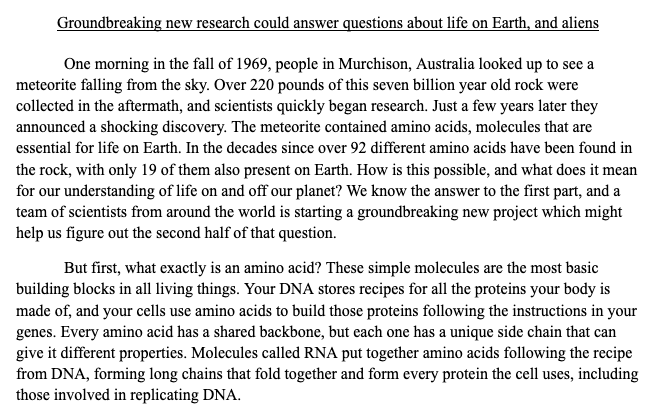To show my ability to translate scientific content for audiences with less familiarity with the subject matter, I decided to write a piece intended for high school audiences. I also thought this could be a good opportunity to demonstrate my skill with creating visuals by designing an infographic to accompany the text.
As I was searching for a subject, my professor, Dr. Stephen Freeland, was beginning a research project investigating how amino acids function, and I thought that would be perfect subject material. Amino acids are such a basic and essential part of biology, yet much about them remains a mystery. The research Dr. Freeland is doing is investigating how our amino acid alphabet might have developed by trying to create a new one. I thought that the subject matter itself was very interesting, and that it would be a straightforward process to create a visually compelling graphic.
The first step for writing this story was determining how much my audience actually knows about the subject material. For this step I interviewed several people in my network who work in high school science education, and learned very helpful information that would guide my writing process. From there I read Dr. Freeland’s papers, conducted an informational interview with him, and did some background research.
The topic of amino acids being found on meteorites that have crashed to earth came up, and I knew I had found my hook. It presents a compelling mystery that pulls a reader in, and the explanation of how the molecules were found on the ancient rock connects directly to the driving motivation of Dr. Freeland’s research. But first I knew it was important to review some basic facts about what amino acids are. High schoolers are familiar with the terms, but don’t have as much familiarity with more specific details.
I planned my visual to accompany the explanation of the function of an amino acid, in order to better aid in readers understanding. Textbooks have diagrams for a reason. Using two methods of communicating information, through images and through words, makes the information more accessible and understandable. This is especially for an audience that has a low level of familiarity and knowledge with the subject matter. For the visual I knew I wanted to provide an overview of how amino acids are used in the cell with some accompanying text. I used a mix of visual metaphors with more literal diagrams, keeping the designs simple and using color to link the different parts.
When writing the story I always kept my audience in mind. I tried to use a minimal amount of technical language and kept the writing style more informal. My goal when writing it was to create something that could inspire curiosity, and in order to do that the reader has to feel engaged and understood. Knowing your audience and being able to speak to them is a critical part of science outreach. If a communicator isn’t able to build connections, their message will go unheard.





